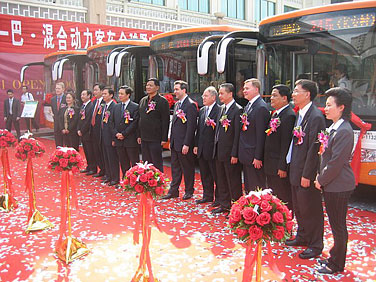|
|
|
||||||||
|
Clean-Energy Trade Mission Opens Opportunities in Two Important Markets A 10-day trade mission to China and India in January gave 17 U.S. companies the opportunity to promote their products and services in those large and growing markets. by Justin Rathke Companies in the clean-energy industry know that you can “do well by doing good.” This maxim was in full effect during the U.S. Department of Commerce’s recent clean-energy trade mission to China and India. The mission, led by David Bohigian, assistant secretary of commerce for market access and compliance, took 17 American clean-energy companies to five cities in China and India on January 8–17, 2008. It built on the groundwork laid by a similar trade mission to those two countries in April 2007. The 17 U.S. companies that participated in the trade mission came from the renewable energy, energy-efficiency, fuel storage, transportation, and clean-energy services sectors.
Successes Already Materializing There were several commercial highlights during the trade mission. One participant, Capstone Turbine Corporation of Chatsworth, California, announced the signing of a new distribution agreement for the oil and gas sector in China with Shanghai Tech-Steel Petroleum and Natural Gas Technology Development Co. In Guangzhou, Eaton Corporation held a signing ceremony for the purchase of 30 hybrid electric buses by the city’s municipal bus company. Eaton designs and manufactures electric and hybrid power systems for commercial vehicles. Investment in the United States Promoted The mission also served as an opportunity to promote the United States as an attractive place for foreign companies to do business. For example, one participating company, AzurePower, Inc., of San Ramon, California, a solar power plant owner and operator, is currently in talks with an Indian entity from West Bengal that is seeking a 10 percent stake in AzurePower, an investment that should facilitate projects for the company in India. Five Cities, Endless Opportunities The five destination cities were chosen because of their robust markets for clean-energy goods and services, spurred by proactive government policies. In China, the mission visited Beijing, which, aside from being the national capital, is also a strong market for clean-energy technologies and the host of the 2008 Summer Olympic Games. The mission also stopped in Guangzhou, the economic center of the Pearl River delta, and Hong Kong, an important financial center. In India, the mission visited Kolkata, the economic hub of eastern India, and Bangalore, which is known as the Silicon Valley of India. Both cities are located in states known for proactive policies to increase clean-energy deployment through incentives, access to preferential financing, and ambitious government targets. Forum, Seminar Help Inform Companies On January 9, in Beijing, the Commerce Department cohosted the inaugural U.S.–China Clean-Energy and Energy-Efficiency Industry Forum with the Chinese Chamber of Commerce for the Import and Export of Machinery and Electronic Products, which is part of the Chinese Ministry of Commerce. The forum highlighted detailed information on the Chinese clean-energy market and Chinese government policies to attract investment and to stimulate trade. Clean-energy projects can present specific challenges regarding financing because the market has not yet fully embraced many alternative technologies. The Commerce Department organized a half-day seminar during the mission’s stop in Hong Kong on January 12 to better inform participants of innovative finance solutions. One of the topics discussed at the seminar was the Pollution Prevention and Energy-Efficiency program, a joint U.S.–Chinese financing framework for pollution abatement efforts. Repeat Mission to Come “The continuing rapid growth of the Chinese and Indian economies presents unparalleled opportunities and challenges,” noted Bohigian. “U.S. clean-energy companies can help China and India meet their enormous energy demands while deploying technology that benefits the environment.” During the trade mission, Chinese and Indian companies made it clear that there is a market for U.S. products and services in their respective countries, and plans are already being made for another clean-energy delegation to those two markets. Justin Rathke is an international trade specialist in the Manufacturing and Services unit of the International Trade Administration.
|
|
